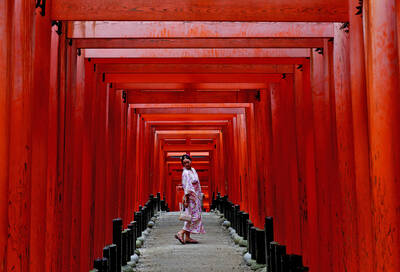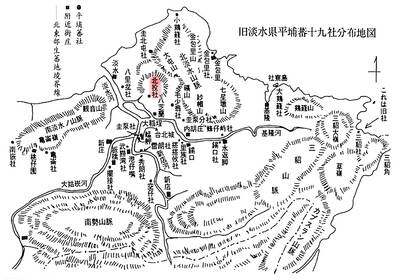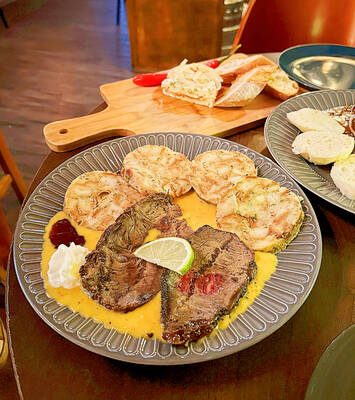It’s in Japanese (with Chinese subtitles), and consists of two hours of people battling against the belief that life is a crock, and generally having this belief vindicated. Yet somehow, through some magic that is hard to pin down, Villon’s Wife (Viyon no Tsuma) manages to be, not exactly uplifting, but at least life-affirming. Moreover, although it is based on a novel by Osamu Dazai, published in 1947, the tremendous performances from the principles, the tightly structured narrative and the deceptively simple cinematography give Villon’s Wife a cinematic presence rarely achieved by literary adaptations.
The appeal of the film is all the more remarkable given its obsession with the themes of self-loathing and suicide. It tells the story of Sachi, a simple girl married to a talented but self-destructive writer, Otami, who, almost against his will, does everything in his power to make her life intolerable. The potential for self-indulgent sentimentality is enormous, but director Kichitaro Negishi, who has already picked up the Montreal World Film Festival prize for best director last year, handles his material with a non-judgmental sensitivity that allows even the brutish Otami a claim on our understanding.
The character of Otami, played with enormous subtlety by Tadanobu Asano, manages to remain sympathetic despite his drunken bouts, his infidelity, his dishonesty, and his self-pity. He is a kind of poet of death, idolized by young would-be intellectuals, who hates the very talent that makes him so appealing.
His wife Sachi (Matsuda Seiko) starts off as one of those eternally put-upon women so much beloved of Japanese soap opera, but grows into a luminous presence as time and again she overcomes the trials of her husband’s behavior — which range from stealing money from his regular drinking house to attempting suicide with a death-infatuated fan. It is indicative of the fascinating twists of this film that one of the greatest moments of Sachi’s liberation and empowerment comes when she decides to give herself to a former lover and lawyer as payment for the legal defense of her husband on charges of attempted murder.
The emotional cues in Villon’s Wife are refreshingly unexpected, a fact that may stem from author Dazai’s intimate relationship with self-loathing, guilt and suicide (he successfully killed himself in 1948 aged 38 after numerous attempts dating from his school days). For Dazai, the longing for death was not just a literary device, it was an obsession, and this story manages to explore a life bereft of self-control with clear eyes.
The romanticism of death suggests such poetic evocations as Keats’ “To cease upon the midnight with no pain/while thou art pouring forth thy soul abroad,” but Villon’s Wife never lets the audience forget the grubby selfishness of self-destruction, undermining the romanticism that is so carefully cultivated in the character of Otami.
As Otami flounders in his own self-created hell, oscillating from vicious self-assurance to mewling self-pity, Sachi clings on to the baseline of her existence — her son, her femininity, and a vitality that she believes can survive even in the barren soil of her relationship with Otami, who she feels committed to, for better or worse.
Negishi is a deft storyteller, making clever use of elision and mood to carry the story forward at a steady and assured pace. His characters are often confined within the tight frame of small streets and smaller houses, and when the camera opens up onto a beautiful forest scene, this turns out to be the chosen spot for suicide.
Villon’s Wife has some fleeting echos of the works of Yukio Mishima, a near contemporary, hinting at a similar schizophrenic response to Japan’s defeat in World War II and the crisis of identity that it engendered. While social context is deep in the background of this film, it still provides a resonant base note that also makes Villon’s Wife an interesting portrait of a nation struggling to find itself.

Seven hundred job applications. One interview. Marco Mascaro arrived in Taiwan last year with a PhD in engineering physics and years of experience at a European research center. He thought his Gold Card would guarantee him a foothold in Taiwan’s job market. “It’s marketed as if Taiwan really needs you,” the 33-year-old Italian says. “The reality is that companies here don’t really need us.” The Employment Gold Card was designed to fix Taiwan’s labor shortage by offering foreign professionals a combined resident visa and open work permit valid for three years. But for many, like Mascaro, the welcome mat ends at the door. A

The Western media once again enthusiastically forwarded Beijing’s talking points on Japanese Prime Minister Sanae Takaichi’s comment two weeks ago that an attack by the People’s Republic of China (PRC) on Taiwan was an existential threat to Japan and would trigger Japanese military intervention in defense of Taiwan. The predictable reach for clickbait meant that a string of teachable moments was lost, “like tears in the rain.” Again. The Economist led the way, assigning the blame to the victim. “Takaichi Sanae was bound to rile China sooner rather than later,” the magazine asserted. It then explained: “Japan’s new prime minister is

NOV. 24 to NOV. 30 It wasn’t famine, disaster or war that drove the people of Soansai to flee their homeland, but a blanket-stealing demon. At least that’s how Poan Yu-pie (潘有秘), a resident of the Indigenous settlement of Kipatauw in what is today Taipei’s Beitou District (北投), told it to Japanese anthropologist Kanori Ino in 1897. Unable to sleep out of fear, the villagers built a raft large enough to fit everyone and set sail. They drifted for days before arriving at what is now Shenao Port (深奧) on Taiwan’s north coast,

Divadlo feels like your warm neighborhood slice of home — even if you’ve only ever spent a few days in Prague, like myself. A projector is screening retro animations by Czech director Karel Zeman, the shelves are lined with books and vinyl, and the owner will sit with you to share stories over a glass of pear brandy. The food is also fantastic, not just a new cultural experience but filled with nostalgia, recipes from home and laden with soul-warming carbs, perfect as the weather turns chilly. A Prague native, Kaio Picha has been in Taipei for 13 years and